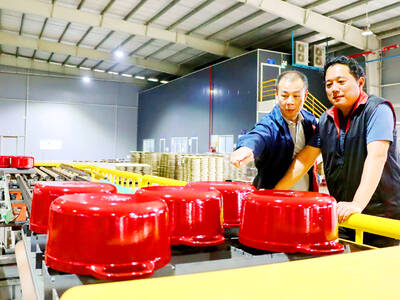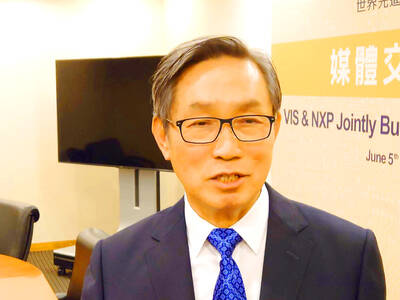Powerchip Semiconductor Corp (力晶半導體), the nation’s largest computer memory chipmaker, is pinning its hopes on an output reduction to stem persistent losses after a strategic alliance among memory chipmakers failed to solve a year-long glut that has sent chip prices falling below cash cost levels.
But analysts are skeptical that the chipmaker’s efforts would help the ailing computer memory, or dynamic random access memory (DRAM), industry, which is facing its severest slump in history.
“As the [reduction] would affect only 10 percent of the company’s [Powerchip’s] commodity DRAM output, we don’t expect investors to react strongly to this announcement,” said George Chang (張家麒), who tracks the DRAM industry for Citigroup, in a report released yesterday.
Investor doubts that the production cut could spur an industrywide recovery was reflected in DRAM stocks’ lackluster trading yesterday, although all DRAM stocks have already plunged to below their NT$10 face value.
The capacity management plan only gave a boost to Powerchip shares, which rose 1.34 percent to NT$4.55, while local rivals fell between 3.01 percent and 6.95 percent. Inotera Memories Inc (華亞科技), a memory venture between Nanya Technology and Germany Qimonda AG, posted the sharpest drop to NT$9.91.
On Monday, Powerchip chairman Frank Huang (黃崇仁) said the chipmaker planned to allocate between 10 percent and 15 percent of its computer memory capacity to manufacture other types of chips to narrow its losses. The company also urged its local peers to follow suit.
“It’s a problem of survival, not of making money,” Huang said.
He said that the latest downturn was the severest he has ever seen during his 18-year career in the DRAM industry, as prices have plunged drastically to a level at which chipmakers could not turn a profit even by using advanced 50-nanometer process technology.
The price for benchmark DRAM chips nose-dived to an all-time low of US$1.65 per unit early this month on the spot market and could drop further as slower-than-expected demand fails to ease the glut, Taipei-based researcher DRAMeXchange Technology Inc (集邦科技) said.
Stricter production management would at least bring the DRAM industry back on track faster at the expense of lower revenues, Huang said.
But Nanya Technology Corp (南亞科技), the nation’s second-biggest DRAM supplier, said yesterday it had no plans of cutting production as this could drive up its factory usage cost.
Cautious analysts like Liu Szu-liang (劉思良), a semiconductor analyst with Yuanta Securities (元大京華證券), said that production reduction might not tilt the supply-demand balance in chipmakers’ favor and was no guarantee that it could hasten the end of the year-long slump.
“Heavyweight players like Samsung Electronics Co are expanding capacity during the slowdown to force small companies to withdraw from the market,” Liu said.
In particular, companies with high inventories are under heavy pressure to survive the downturn as they continue to post massive losses given their dependence on DRAM to generate revenues, he said.
Aggregate losses by Taiwanese makers reached about NT$50 billion (US$1.6 billion) in losses in the first six months of this year.
“Besides, the latest downturn is different from the last one in 2000,” Liu said.
DRAM firms regained momentum as output dropped sharply following major consolidations, he said.
“This time, the recovery will only come after demand strongly rebounds, or companies that run out of cash are forced out of the market,” Liu said.

STEEP DECLINE: Yesterday’s drop was the third-steepest in its history, the steepest being Monday’s drop in the wake of the tariff announcement on Wednesday last week Taiwanese stocks continued their heavy sell-off yesterday, as concerns over US tariffs and unwinding of leveraged bets weighed on the market. The benchmark TAIEX plunged 1,068.19 points, or 5.79 percent, to 17,391.76, notching the biggest drop among Asian peers as it hit a 15-month low. The decline came even after the government on late Tuesday authorized the NT$500 billion (US$15.2 billion) National Stabilization Fund (國安基金) to step in to buoy the market amid investors’ worries over tariffs imposed by US President Donald Trump. Yesterday’s decline was the third-steepest in its history, trailing only the declines of 2,065.87 points on Monday and

TAKING STOCK: A Taiwanese cookware firm in Vietnam urged customers to assess inventory or place orders early so shipments can reach the US while tariffs are paused Taiwanese businesses in Vietnam are exploring alternatives after the White House imposed a 46 percent import duty on Vietnamese goods, following US President Donald Trump’s announcement of “reciprocal” tariffs on the US’ trading partners. Lo Shih-liang (羅世良), chairman of Brico Industry Co (裕茂工業), a Taiwanese company that manufactures cast iron cookware and stove components in Vietnam, said that more than 40 percent of his business was tied to the US market, describing the constant US policy shifts as an emotional roller coaster. “I work during the day and stay up all night watching the news. I’ve been following US news until 3am

Six years ago, LVMH’s billionaire CEO Bernard Arnault and US President Donald Trump cut the blue ribbon on a factory in rural Texas that would make designer handbags for Louis Vuitton, one of the world’s best-known luxury brands. However, since the high-profile opening, the factory has faced a host of problems limiting production, 11 former Louis Vuitton employees said. The site has consistently ranked among the worst-performing for Louis Vuitton globally, “significantly” underperforming other facilities, said three former Louis Vuitton workers and a senior industry source, who cited internal rankings shared with staff. The plant’s problems — which have not

TARIFF CONCERNS: The chipmaker cited global uncertainty from US tariffs and a weakening economic outlook, but said its Singapore expansion remains on track Vanguard International Semiconductor Corp (世界先進), a foundry service provider specializing in producing power management and display driver chips, yesterday withdrew its full-year revenue projection of moderate growth for this year, as escalating US tariff tensions raised uncertainty and concern about a potential economic recession. The Hsinchu-based chipmaker in February said revenues this year would grow mildly from last year based on improving supply chain inventory levels and market demand. At the time, it also anticipated gradual quarter revenue growth. However, the US’ sweeping tariff policy has upended the industry’s supply chains and weakened economic prospects for the world economy, it said. “Now